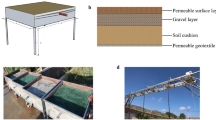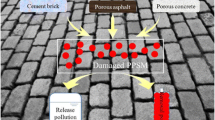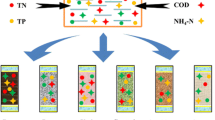Abstract
Permeable pavements (PPs) are used to address water quality impacts from urban roads. However, the effectiveness of different structure combinations in removing runoff pollutants throughout the permeable system remains unclear. In this study, 26 PP structures were tested to investigate their pollutant removal efficiency by the self-developed laboratory apparatus to provide a quantitative understanding of these combinations. The results showed PP was the most effective in removing total suspended solids (TSS) and lead (Pb) among all pollutants studied, with maximum removal rates of 91% and 96%, respectively. PP also can remove ammonia (NH4+-N), nitrogen (TN), phosphorous (TP), and chemical oxygen demand (COD) to some extent; the removal rate was 1 ~ 36%. Furthermore, the pollutant removal efficiency was not dependent on a simple stacked combination of structures or materials. The combined surface structure of permeable asphalt mixture (PAM) and permeable cement concrete (PCC) was more effective in removing runoff pollutants than a single surface structure of the same thickness, and the optimal surface layer thickness (8 cm) and base course thickness (26 cm) of PCC were recommended respectively. Based on experiment findings, the relationships between TSS removal rates and the other six pollutants were established, and independent target pollutants removal rates (75%, 80%, 85%) based on TSS were selected for proposing a series of PP structures and thicknesses. The insights generated from this study will help in the design and implementation of PP for runoff pollution abatement.






Similar content being viewed by others
Data Availability Statement
All data generated or analyzed during this study are included in this published article.
References
AASHTO. (2014). Standard method of test for percent air voids in compacted dense and open asphalt mixtures, T269-11-UL, Washington, DC.
Antunes, L. N., Ghisi, E. & Thives, L. P. (2018). Permeable pavements life cycle assessment: A literature review. Water, 10(1575), 1–17. https://doi.org/10.3390/w10111575
Brattebo, B. O., & Booth, D. B. (2003). Long-term stormwater quantity and quality performance of permeable pavement systems. Water Research, 37, 4369–4376. https://doi.org/10.1016/S0043-1354(03)00410-X
China (1987a). GB 7467–1987a: Water quality-Determination of chromiun(VI)-1,5 Dtphenylcarbohydrazide spectrophotometric method. Ministry of Ecology and Environment of the People's Republic of China.
China (1987b). GB/T 7475–1987b: Quality - Determination of copper, zinc, lead and cadmium - Atomic absorption spectrometry. Ministry of Ecology and Environment of the People's Republic of China.
China (1989a). GB 11893–1989a: Water quality-determination of total phosphorus-ammonium molybdate spectrophotometric method. Ministry of Ecology and Environment of the People's Republic of China.
China (1989b). GB 11901–1989b: Water quality-determination of suspended substance-gravimetric method. Ministry of Ecology and Environment of the People's Republic of China.
China (2009a). HJ 535–2009:Water quality―Determination of ammonia nitrogen―Nessler’s reagent spectrophotometry. Ministry of Ecology and Environment of the People’s Republic of China.
China (2009b). CJJ/T 134–2009: Technical specifications for pervious concrete pavement. Ministry of housing and urban-rural development of People’s Republic of China.
China (2011). JTG E20–2011: Standard test methods of bitumen and bituminous mixtures for highway engineering. Ministry of Transport of People's Republic of China.
China (2012a). HJ 636—2012: Water quality-determination of total nitrogen-Alkaline potassium persulfate digestion UV spectrophotometric method. Ministry of Ecology and Environment of the People's Republic of China.
China (2012b). CJJ/T 190–2012: Technical specification for permeable asphalt pavement. Ministry of Housing and Urban-Rural Development of the People's Republic of China.
China. (2015). 15MR205: Urban roads-Environmentally friendly road pavement. China Enstitute of Building Standard Design & Research.
China (2017). HJ 828—2017: Water quality-Determination of the chemical oxygen demand-Dichromate method. Ministry of Ecology and Environment of the People’s Republic of China.
China (2019). HJ J 91.1–2019: Technical specifications for wastewater monitoring. Ministry of Ecology and Environment of the People's Republic of China.
Chen, W., Zheng, M., Gao, Q., Deng, C., Ma, Y., & Ji, G. (2021). Simulation of surface runoff control effect by permeable pavement. Water Science and Technology, 83, 948–960. https://doi.org/10.2166/wst.2021.027
Cui, X., Zhang, J., Zhang, N., Gao, Z., Sui, W., & Wong, C. (2015). Improvement of permeability measurement precision of pervious concrete. Journal of Testing and Evaluation, 43, 812–819. https://doi.org/10.1520/JTE20130176
Gromaire, M. C., Garnaud, S., Saad, M., & Chebbo, G. (2001). Contribution of different sources to the pollution of wet weather flows in combined sewers. Water Research, 35, 521–533. https://doi.org/10.1016/s0043-1354(00)00261-x
Han, S. H., Yang, Y., Liu, S. & Lu, M. B. (2020). Decontamination performance and cleaning characteristics of three common used paved permeable bricks. Environment and Science Pollution Research, 28, 15114–15122.
Hassani, A., Mohammad, S., & Ghoddusi, P. (2010). Runoff infiltration through permeable block pavements. Proceedings of the Institution of Civil Engineers-Transport, 163, 183–190. https://doi.org/10.1680/tran.2010.163.4.183
Hernandez-Crespo, C., Fernandez-Gonzalvo, M., Martin, M., & Andres-Domenech, I. (2019). Influence of rainfall intensity and pollution build-up levels on water quality and quantity response of permeable pavements. Science of the Total Environment, 684, 303–313. https://doi.org/10.1016/j.scitotenv.2019.05.271
Huang, J., Valeo, C., He, J. X. & Chu, A. (2016a). The influence of design parameters on stormwater pollutant removal in permeable pavements. Water Air and Soil Pollution 227, 311. https://doi.org/10.1007/s11270-016-3020-y
Huang, J., Valeo, C., He, J. X., & Chu, A. (2016b). Three Types of Permeable Pavements in Cold Climates: Hydraulic and Environmental Performance. Journal of Environmental Engineering, 142, 04016025. https://doi.org/10.1061/(Asce)Ee.1943-7870.0001085
Jiang, W., Sha, A. M., Xiao, J. J., Li, Y. L., & Huang, Y. (2015). Experimental study on filtration effect and mechanism of pavement runoff in permeable asphalt pavement. Construction and Building Materials, 100, 102–110. https://doi.org/10.1016/j.conbuildmat.2015.09.055
Kamali, M., Delkash, M., & Tajrishy, M. (2017). Evaluation of permeable pavement responses to urban surface runoff. Journal of Environmental Management, 187, 43–53. https://doi.org/10.1016/j.jenvman.2016.11.027
Kang, A., Mao, H., Li, B., Kou, C., Xu, X., & Jahangiri, B. (2019). Investigation of selective filtration characteristics of filter media for pavement runoff treatment. J. Cleaner Prod., 235, 590–602. https://doi.org/10.1016/j.jclepro.2019.06.337
Kuruppu, U., Rahman, A., & Rahman, M. A. (2019). Permeable pavement as a stormwater best management practice: A review and discussion. Environment and Earth Science, 78, 20. https://doi.org/10.1007/s12665-019-8312-2
Li, H., Li, Z., Zhang, X., Li, Z., Liu, D., Li, T., & Zhang, Z. (2017). The effect of different surface materials on runoff quality in permeable pavement systems. Environmental Science and Pollution Research, 24, 21103–21110. https://doi.org/10.1007/s11356-017-9750-6
Liu, J. Y., & Borst, M. (2018). Performances of metal concentrations from three permeable pavement infiltrates. Water Research, 136, 41–53. https://doi.org/10.1016/j.watres.2018.02.050
Liu, W., Feng, Q., Chen, W., & Deo, R. C. (2020). Stormwater runoff and pollution retention performances of permeable pavements and the effects of structural factors. Environmental Science and Pollution Research, 27, 30831–30843. https://doi.org/10.1007/s11356-020-09220-2
Liu, T. Q., Lawluvy, Y., Shi, Y. & Yap, P. S. (2021). Low impact development (LID) practices: A review on recent developments, challenges and prospects. Water Air and Soil Pollution 232, 344. https://doi.org/10.1007/s11270-021-05262-5
Luo, H., Guan, L., Jing, Z., Zhang, Z., Hu, X., Tao, M., & Wang, Y. (2020). Influence of filter layer positions and hydraulic retention time on removal of nitrogen and phosphorus by porous asphalt pavement, Water Sci. Technol., 81, 445–455. https://doi.org/10.2166/wst.2020.110
Murphy, L. U., Cochrane, T. A. & O'Sullivan, A. (2015) The influence of different pavement surfaces on atmospheric copper, lead, zinc, and suspended solids attenuation and wash-off. Water Air and Soil Pollution, 226, 232. https://doi.org/10.1007/s11270-015-2487-2
Niu, Z. G., Lv, Z. W., Zhang, Y., & Cui, Z. Z. (2016). Stormwater infiltration and surface runoff pollution reduction performance of permeable pavement layers. Environmental Science and Pollution Research, 23, 2576–2587. https://doi.org/10.1007/s11356-015-5466-7
Ortega-Villar, R., Lizarraga-Mendiola, L., Coronel-Olivares, C., Lopez-Leon, L. D., Bigurra-Alzati, C. A., & Vazquez-Rodriguez, G. A. (2019). Effect of photocatalytic Fe2O3 nanoparticles on urban runoff pollutant removal by permeable concrete. Journal of Environmental Management, 242, 487–495. https://doi.org/10.1016/j.jenvman.2019.04.104
Wang, J., Wang, M., Che, W., Li, J., Zhao, Y., & Wang, W. (2015). Discussion on key issues in construction of stormwater drainage system based on low impact development. China Water & Wastewater, 31, 6–12. https://doi.org/10.19853/j.zgjsps.1000-4602.2015.22.002
Wang, J., Xu, Y., Wei, S., Zhang, Y., Feng, C., & Li, J. (2016). Experiment on the removal of road runoff pollutants in each structure layer of permeable concrete pavement. Environmental Engineering, 34, 39–43.
Wang, H.-W., Zhai, Y.-J., Wei, Y.-Y., & Mao, Y.-F. (2019). Evaluation of the effects of low-impact development practices under different rainy types: Case of Fuxing Island Park, Shanghai, China. Environmental Science and Pollution Research, 26, 6706–6716. https://doi.org/10.1007/s11356-019-04129-x
Wiesmann, U. (1994). Biological nitrogen removal from wastewater. Advances in Biochemical Engineering/Biotechnology, 51, 113–154. https://doi.org/10.1007/BFb0008736
Xie, N., Akin, M., & Shi, X. M. (2019). Permeable concrete pavements: A review of environmental benefits and durability. Journal Cleaner Production, 210, 1605–1621. https://doi.org/10.1016/j.jclepro.2018.11.134
Zachary Bean, E., Frederick Hunt, W., & Alan Bidelspach, D. (2007). Evaluation of four permeable pavement sites in Eastern North Carolina for runoff reduction and water quality impacts. Journal of Irrigation and Drainage Engineering, 133, 583–592. https://doi.org/10.1061/(asce)0733-9437(2007)133:6(583)
Zhang, Z. Y., Li, Z. F., Zhang, X. R., Liu, D. Q., Li, Z. R., & Li, H. Y. (2018). Systematically investigated the influences of permeable pavement materials on the water quality of runoff: Batch and column experiments. Water Air and Soil Pollution, 229, 155. https://doi.org/10.1007/s11270-018-3772-7
Zheng, M., Song, D., Lei, B., Wang, K., Liu, S. & Li, S. (2019). Device and method for testing penetration performance attenuation law of sponge city permeable pavement. China CN110320147A.
Funding
The research was sponsored by the National Natural Science Foundation of China (Grant No. 52078051), Fundamental Research Funds for the Central Universities (310821163502), the Xixian New District Management Committee of Shaanxi Province (2017 44), the Science and Technology Bureau of Pingdingshan of China (2018610002000604), and the Transportation Department of Zhuhai (JT-HG-2020–21).
Author information
Authors and Affiliations
Corresponding author
Ethics declarations
Competing Interests
The authors declare no competing interests.
Additional information
Publisher's Note
Springer Nature remains neutral with regard to jurisdictional claims in published maps and institutional affiliations.
Rights and permissions
About this article
Cite this article
Zheng, M., Chen, W., Gao, Q. et al. Research on the Reduction Performance of Surface Runoff Pollution Through Permeable Pavement with Different Structures. Water Air Soil Pollut 233, 147 (2022). https://doi.org/10.1007/s11270-022-05619-4
Received:
Accepted:
Published:
DOI: https://doi.org/10.1007/s11270-022-05619-4




